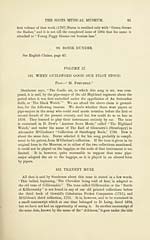Inglis Collection of printed music > Printed text > Early Scottish melodies
(114) Page 92 - To the weavers gin ye go
Download files
Complete book:
Individual page:
Thumbnail gallery: Grid view | List view

92 EAELY SCOTTISH MELODIES.
of the " Irish Gilchranky," and is a version of the air printed in the Museum.
The song appeared in " The Charmer," Edinburgh, 1751.
103. TO THE WEAVEE'S GIN YE GO.
The tune to this song is called " The Weaver's March," and is contained
in the second volume of James Aird's " Selection of Scotch, English, Irish,
and Foreign Airs," 1782, under the same title as the song.
104. STREPHON AND LYDIA.
Tibne — "The Gordons has the guiding o't.
We have failed to discover this tune in any collection whatever before
the publication of the Museum, therefore we do not venture to say any-
thing about its age. We may remark of the tune that the second strain
differs very little from the first one.
105. ON A ROCK BY SEAS SURROUNDED.
Tune — "Ianthy the Lovely."
In the Museum the tune has been misnamed ; it is not " Ianthy the
lovely," which we have already noticed. Both the melody and song are
said to be the composition of Dr Beattie of Aberdeen, from whom
Johnson received them. At any rate, neither are to be found earlier than
the Museum.
106. WHISTLE AN I'LL COME TO YOU, MY LAD.
It is said by Stenhouse, " This air has generally been considered of Irish
origin, because it was adapted to a song written by John O'Keefe, Esq., in
his comic opera of the ' Poor Soldier,' which was first acted at Covent Garden
in 1783." Stenhouse adds, " But the tune was composed by the late John
Bruce, an excellent fiddle-player in Dumfries, upwards of thirty years
before that period." Burns says, " This I know, Bruce, who was an honest
man, though a red-wud Highlander, constantly claimed it, and by all the
old musical people here (viz. Dumfries) he is believed to be the author of
it." (Cromek's " Reliques.") The air was known to Burns before he went
to Ellisland, as the second volume of the Museum was issued in April
1788. John Mayne, the author of " The Siller Gun," who was born in
Dumfries, but left that town when twenty years of age, says, " Bruce never
was known as a composer of music," while Burns, who in riper years lived
of the " Irish Gilchranky," and is a version of the air printed in the Museum.
The song appeared in " The Charmer," Edinburgh, 1751.
103. TO THE WEAVEE'S GIN YE GO.
The tune to this song is called " The Weaver's March," and is contained
in the second volume of James Aird's " Selection of Scotch, English, Irish,
and Foreign Airs," 1782, under the same title as the song.
104. STREPHON AND LYDIA.
Tibne — "The Gordons has the guiding o't.
We have failed to discover this tune in any collection whatever before
the publication of the Museum, therefore we do not venture to say any-
thing about its age. We may remark of the tune that the second strain
differs very little from the first one.
105. ON A ROCK BY SEAS SURROUNDED.
Tune — "Ianthy the Lovely."
In the Museum the tune has been misnamed ; it is not " Ianthy the
lovely," which we have already noticed. Both the melody and song are
said to be the composition of Dr Beattie of Aberdeen, from whom
Johnson received them. At any rate, neither are to be found earlier than
the Museum.
106. WHISTLE AN I'LL COME TO YOU, MY LAD.
It is said by Stenhouse, " This air has generally been considered of Irish
origin, because it was adapted to a song written by John O'Keefe, Esq., in
his comic opera of the ' Poor Soldier,' which was first acted at Covent Garden
in 1783." Stenhouse adds, " But the tune was composed by the late John
Bruce, an excellent fiddle-player in Dumfries, upwards of thirty years
before that period." Burns says, " This I know, Bruce, who was an honest
man, though a red-wud Highlander, constantly claimed it, and by all the
old musical people here (viz. Dumfries) he is believed to be the author of
it." (Cromek's " Reliques.") The air was known to Burns before he went
to Ellisland, as the second volume of the Museum was issued in April
1788. John Mayne, the author of " The Siller Gun," who was born in
Dumfries, but left that town when twenty years of age, says, " Bruce never
was known as a composer of music," while Burns, who in riper years lived
Set display mode to: Large image | Transcription
Images and transcriptions on this page, including medium image downloads, may be used under the Creative Commons Attribution 4.0 International Licence unless otherwise stated. ![]()
| Special collections of printed music > Inglis Collection of printed music > Printed text > Early Scottish melodies > (114) Page 92 - To the weavers gin ye go |
|---|
| Permanent URL | https://digital.nls.uk/94644640 |
|---|---|
| Description | Also: Strephon and Lydia. Also: On a rock by the seas surrounded. Also: Whistle and I'll come to you, my lad. |
| Description | Scottish and English songs, military music and keyboard music of the 18th and 19th centuries. These items are from the collection of Alexander Wood Inglis of Glencorse (1854 to 1929). Also includes a few manuscripts, some treatises and other books on the subject. |
|---|
| Description | The Glen Collection and the Inglis Collection represent mainly 18th and 19th century Scottish music, including Scottish songs. The collections of Berlioz and Verdi collected by bibliographer Cecil Hopkinson contain contemporary and later editions of the works of the two composers Berlioz and Verdi. |
|---|

